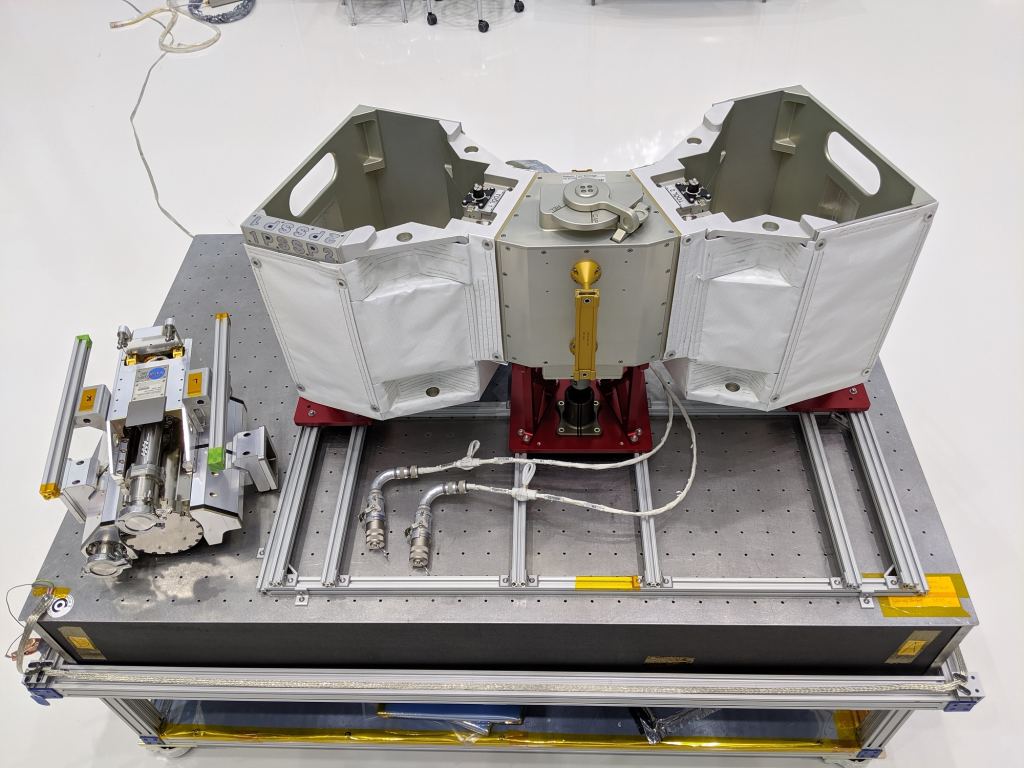Robotic helpers are becoming an increasingly important element aboard the International Space Station. It is here where robots like the Robonaut, CIMON, FEDOR, Canadarm2, Dextre, and CIMON 2 (which is currently on its way to the ISS) were tested and validated for space operations. In recent years, the Robotic External Leak Locators (RELL) also proved their worth by conducting extra-vehicular activities (EVAs) and finding leaks.
Unfortunately, sending these robots out to do their tasks has been a long and complicated process. For this reason, NASA has created a new housing unit called the Robotic Tool Stowage (RiTS). Developed by the Satellite Servicing Projects Division at NASA’s Goddard Space Flight Center (with support from the Johnson Space Center), this “robot hotel” launched yesterday (Dec. 4th) and will soon be integrated with the station.
The first residents of the RiTs will be two additional Robotic External Leak Locators (RELL), which are machines that use mass spectrometers to “sniff” out the presence of gases that could be leaking from the ISS. Two RELL units are already onboard the ISS right now, the first of which was sent back in 2015 and successfully detected two leaks since its arrival.
For this reason, a second RELL was sent there earlier this year, followed by the two that are scheduled for launch. The addition of the RiTS will assist with their operations by allowing the space station’s robotic arm (Dextre) to easily locate, grab, and return them to an external storage space once they’re finished their operations. As Mark Neuman, the RiTS hardware manager, explained:
“For each of its stored tools, RiTS will provide heat and physical protection from radiation and micrometeroids, or tiny, high-speed objects hurtling through space. Its thermal system maintains ideal temperatures for the instruments, helping them stay functional.”
To keep temperatures aboard the ISS steady, NASA relies on a complicated network of ammonia pumps, reservoirs, and radiators. This vast network, which is similar to a central air conditioning system, consists of hundreds of meters of tubing and hundreds of joints. Over time, this system has suffered the occasional leak, thanks in large part to micrometeoroid impacts.
While such leaks pose no immediate risk to the crew, they can affect the station’s cooling system which would negativity impact conditions aboard the ISS. Previously, detecting and addressing possible leaks aboard the station could take weeks or even months. This was due in part to the fact that once a RELL deployed to space, it would need to wait for 12 hours before it could get to work.

This was to ensure that the RELL’s extremely sensitive gas analyzer can clear itself of water vapor and other gases that are common aboard the station (and which would interfere with the detection of ammonia). However, with the RiTS as part of the station, the entire process would depend exclusively on Dextre’s availability, expediting the search for leaks considerably.
RiTS will even be mounted to the same robotic platform that moves Dextre up and down on the external rails of the station, which will ensure that a RELL tool will always be accessible. Said Chris Craw, NASA Senior Systems Integration Lead:
“This hardware will significantly reduce time and cost for the station crew to deploy leak detection capabilities using Dextre. With RiTS, we’ll have easier and faster access to RELL, which can help ensure our astronauts’ safety in space.”
Once it reaches the ISS, the RiTS will be installed to the station’s exterior by astronauts during a spacewalk. Looking to the future, similar units could be applied to exploration missions to the Moon, Mars, and beyond. In the near future, RiTS units and RELL tools could be used to detect potential leaks aboard the Lunar Gateway, or as part of the maintenance of lunar or Martian habitats.
Just one of the many ways in which robots and humans are working together to advance space exploration.
Further Reading: NASA
Science - Latest - Google News
December 06, 2019 at 06:57AM
https://ift.tt/34ZszE3
Astronauts are Going to Attach a "Robot Hotel" to the Outside of the International Space Station - Universe Today
Science - Latest - Google News
https://ift.tt/2Kb7H4e
Shoes Man Tutorial
Pos News Update
Meme Update
Korean Entertainment News
Japan News Update
Bagikan Berita Ini














0 Response to "Astronauts are Going to Attach a "Robot Hotel" to the Outside of the International Space Station - Universe Today"
Post a Comment